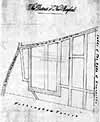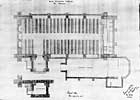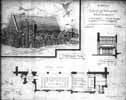For this church:    |
Basford St AugustineHistory
The Ecclesiastical District of New Basford was formed on March 9th 1847 as a Peel District in the patronage of the Crown and Bishop alternately. This lasted until 1960 when it was invested in the Crown alone. It had no church but the incumbent, the Rev. Thomas Ambler Bolton, was paid £130 p.a. by the Ecclesiastical Commissioners to conduct services in a licensed building. He moved to the village in 1847 and in 1848 he hired two rooms in Olive Square at his own expense, one for a church and one for a school. The church room was originally a workshop. In 1854 the Rev. T. Gawtherne of Southwell gave a plot of land in New Basford for a church. The Rev. T.A. Bolton set about trying to raise funds for erecting one, and actually wrote that he had obtained grants from the Ecclesiastical Commissioners and the Church Building Society (CERC 15135). However, a fund-raising appeal in c.1870 asserted that he paid for all the building work himself (PR 24,373). In a letter of 23 July 1860 he wrote to the Rev H. Pitman, ‘I could do bettter without a grant from the ICBS and have done so’ (ICBS 5154, Lambeth Palace). Bolton wrote, in 1850, that the population was too poor to contribute anything, nor was there any affluent person in the area who was interested in the Anglican church. In fact one person was keen to buy land to prevent a church being built. ‘A worse place for the Church to work in could not be found,’ moaned Bolton. New Basford was ‘a place abounding with almost all kinds of heresy, schism and irreligion’. Indeed, his successor the Rev. J. T. McCallan was stoned at his first service in 1868. The first church, which opened in 1859, was designed by the Nottingham architect, Arthur Wilson, in such a way that it could be adapted at some future date as an aisle of an enlarged church. Bolton also paid for a new school nearby, so both church and school were privately owned. White’s Directory (1864) was fulsome in its praise, calling it ‘a handsome little church’ with ‘the interior exceedingly beautiful, richly decorated with carving, and is a very close revival of Catholic antiquity’. The building was 75 feet long and 28 feet high to the roof slates, in the First Pointed style (CERC 15135). After the Rev. T. A. Bolton died in 1868 the church and school passed to his wife, who gave the church to the parish. She sold the school for £700 and the parish quickly enlarged it. A fund was set up to pay for that and for a new church to add to the original building. The latter had been consecrated by the Bishop of Lincoln but rejected by Ewan Christian, the Ecclesiastical Commissioners’ architect, as ‘unfit to remain part of a permanent church.’ A much bigger church was urgently needed as, by 1870, five Sunday services were held simultaneously in church and school yet there was still not room for all.
Robert Evans of Evans & Jolley, the Nottingham architects, made minor adjustments to the plans and Mr. Christian did not oppose them when they were re-submitted in 1875, although the old church was retained. The foundation stone was laid on October 23rd 1875 and the enlarged church, consisting of the 1859 church building with a new nave and south porch, was consecrated on February 15th 1877. The Rev. J.T. McCallan had been urging the authorities to let him conduct marriages since 1870 but was only now allowed to do so. The contractors S & W Pattinson of Sleaford were paid £2500 in seven instalments between February 1876 and April 1877, but Evans & Jolley had to wait until 1880 for their final payment. The final overall cost was £6700, of which The Incorporated Society for Promoting the Enlargement, Building and Repairing of Churches and Chapels contributed £300. All 550 seats were free and unappropriated. No spire or tower was contemplated then, the existing bell turret having to suffice. However, a north aisle was added in 1884, courtesy again of Evans & Jolley, at a cost of £630 which was paid for by the vicar, the Rev. S. Bourne, and the churchwardens. The addition of a chancel was first mooted in 1892 and it was consecrated on April 13th, 1895 at a cost of over £1500. Apart from
a choir vestry on the north side in 1908 no further major alterations were
made, although some were contemplated in 1914 as shown on the A Mission Room was established on Elson Street in 1909 then moved to a disused factory on Palm Street in 1913. Outdoor services were still being held in the parish in 1922. The connection between church and school continued until the 1980s. A plea for a parsonage was made as early as March 1853. Eventually one was built in c.1870 on Nottingham Road for £2000 on land given by the Duke of Newcastle. It had five bedrooms, a wine cellar and a butler’s pantry but was said to be uncomfortable. It was sold in 1964 and is now a Sikh temple. The new vicarage from 1963 was at 14 Claremont Road, Sherwood Rise. The parish was greatly indebted to the Rev. Thomas Bolton for his generosity and hard work in establishing an Anglican presence in a bastion of non-conformity. The Rev. John McCallan carried on the work and supervised the fund raising for, and building of, the main church in the 1870s, in what must have been an exciting incumbency. He took a prominent part in public life, serving on the School Board of Basford and, after 1877, on that of the Borough. He died in office in 1883 and was succeeded by his brother-in-law William Danks who stayed only one year. His successor Stephen Bourne was at loggerheads with the Vestry members in 1887-88 over money matters and left a few months later. He was followed by the Rev. Arthur Dewick who objected to inmates of the Workhouse being included in his parish in the Census for 1901. (They were installed in an old factory on Beech Avenue while waiting for Bagthorpe Workhouse to be completed.) In December 1902 a curate’s licence was granted to the Rev.Theodore Bayley Hardy who was a schoolmaster at Nottingham High School. He was the curate for five years. In the First World War he volunteered for service as a padre at the age of 51, never fired a shot but won the VC, DSO and MC for outstanding gallantry when helping wounded and dying soldiers at the Front. He died of wounds only 3 weeks before the Armistice. The original boundaries of New Basford were laid down in 1847. To the north was Northgate, on the east land belonging to the Duke of Newcastle, in the south it reached to the Forest and in the west to ‘Nottingham Road by Ison Green’ (See map PR 24,298). Further growth in building and population led to an extension of the boundaries in 1897, when New Basford legally acquired the status of a new parish. In the south-west the boundary was now partly formed by the new parish of Hyson Green, south-east by the new parish of All Saints’, Nottingham, east by the Particular District of St John’s, Carrington, and north and north-west by an imaginary line starting at the junction of Hucknall Road and Haydn Road then extending along Northgate west or south-west to the boundary dividing Basford from New Basford, i.e. the present Radford Road. As so often with the new villages springing up around Nottingham in the 1820s, Methodists were well catered for in New Basford. The Wesleyan Chapel on Mount Street was built in the 1820s, and the large room rented by Rev. Thomas Bolton in 1848 had previously been used by Non-conformists. From 1833-1836 it was used by an Assembly which then joined another sect of Dissenters, the Wesleyan Association Methodists, who had a substantial chapel on Palm Street. In 1857 they amalgamated with the Wesleyan Reformers, leading to the United Methodist Free Churches. For many years Palm Street Chapel was so popular it was full half an hour before the evening service began. The Methodist fervour had persisted since at least 1825 when it was said that there were so many converts to Wesleyanism at New Basford ‘the people appear to be panic struck’. Their fervent beliefs led to antagonism of the Church of England which, in turn, was scarcely less tolerant of Methodism in the village. In 1877 there were Wesleyan chapels on Mount Street and High Church Street, the Primitive Methodists worshipped on Duke Street, and there were two Baptist chapels on Pepper Street and Chapel Street. At this time the Methodists had 2,170 sittings in New Basford compared to a maximum of 600 at St Augustine’s. |




 drawing
drawing


